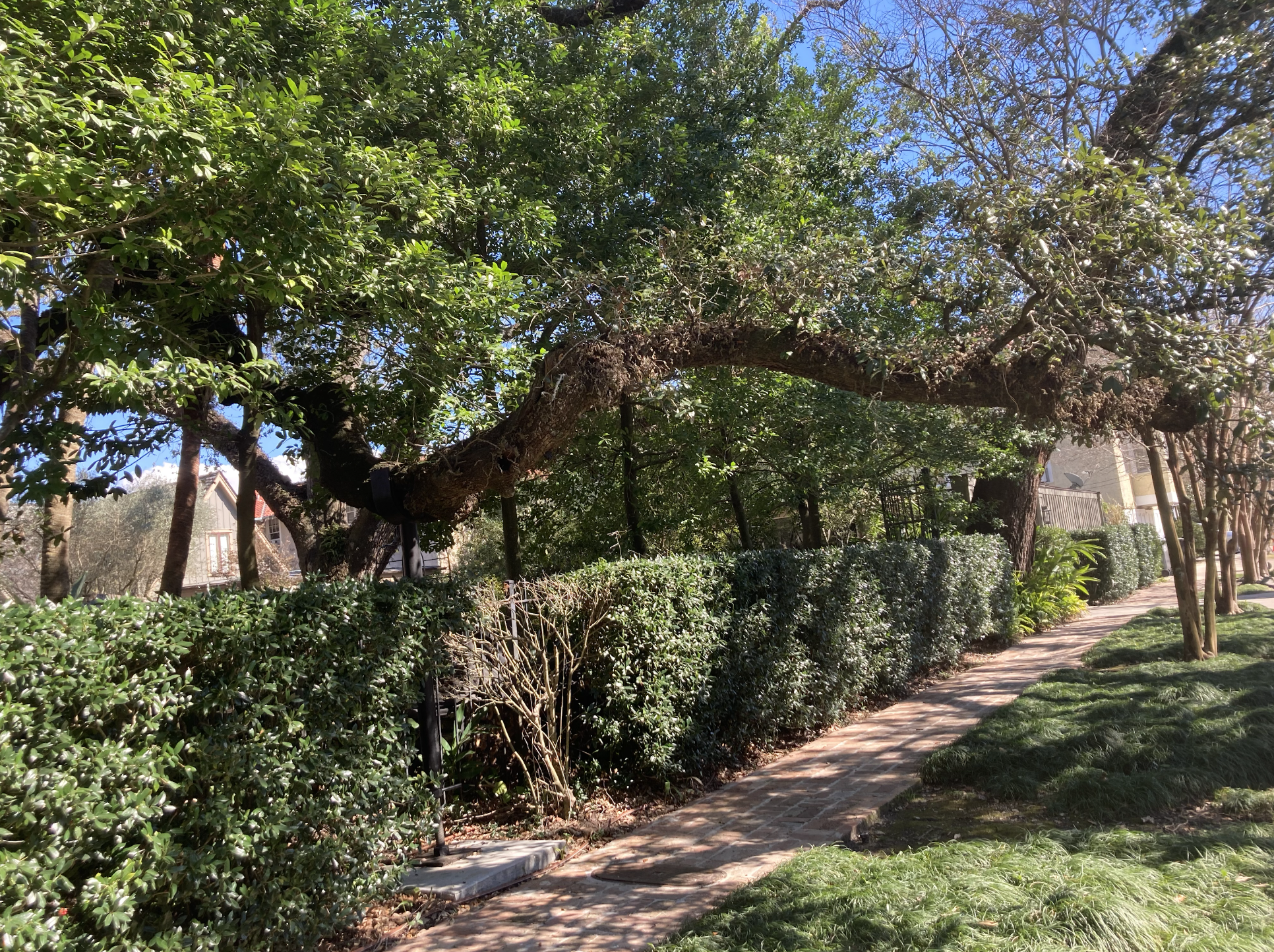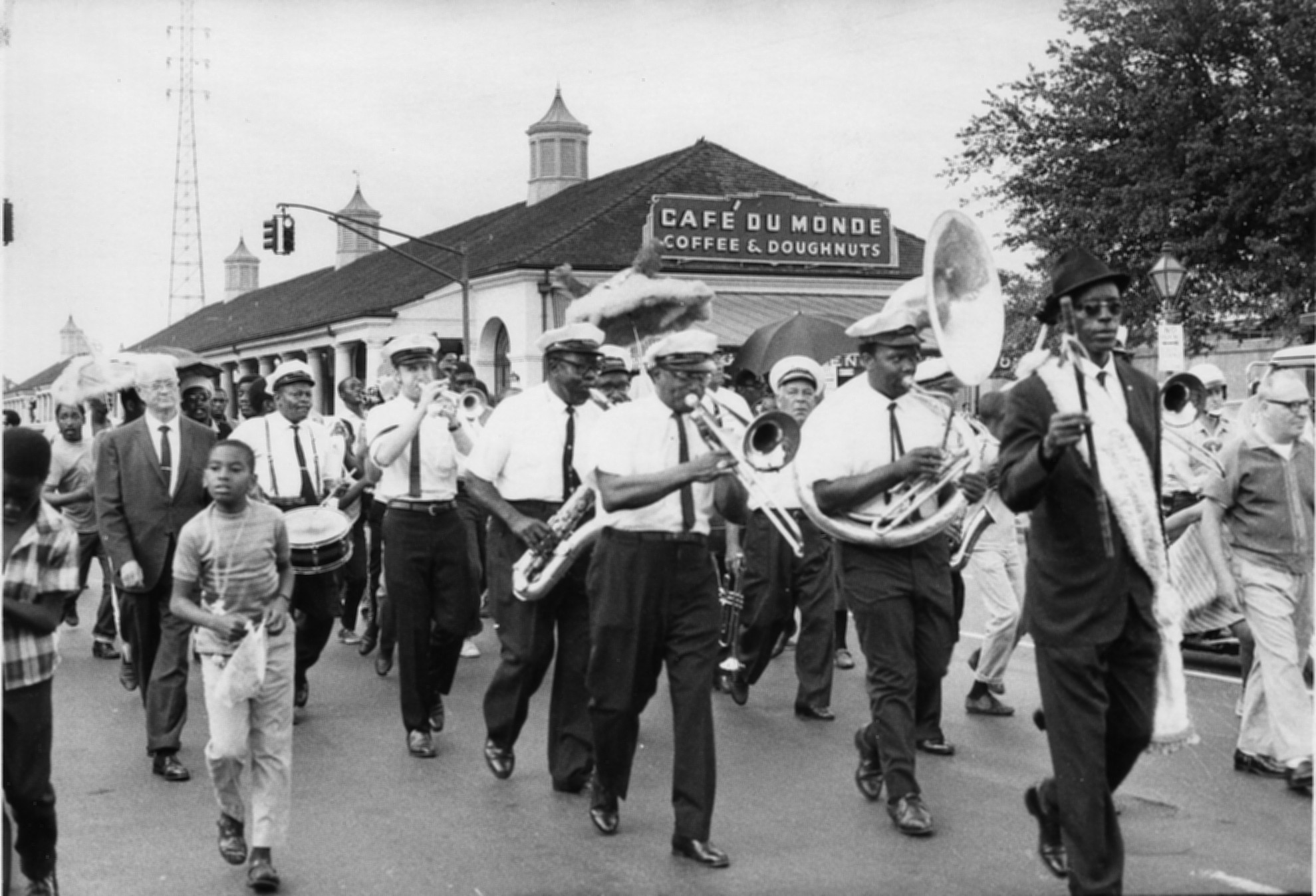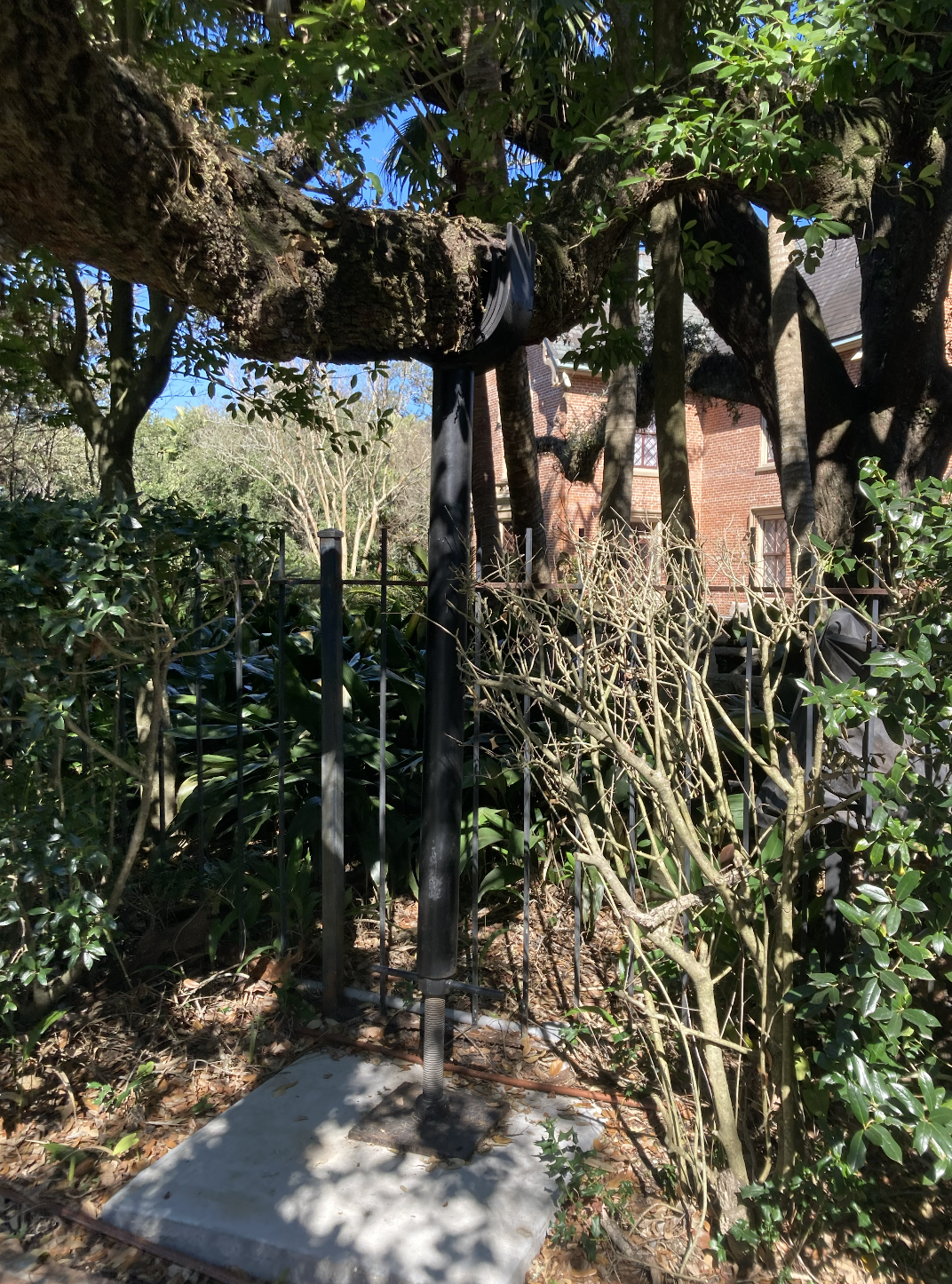
A long branch extends over a sidewalk street lined with bushes and grass. (Photo by Helena Adler)
Only a 15-minute walk from Tulane’s uptown campus, bustling commercial and residential South Carrollton Avenue is lush with greenery . One house, on the corner of Freret Street and South Carrollton sticks out from the rest. The Nathaniel Wilkinson House, built in 1849, was erected in the Gothic style uncommon to New Orleans. The sprawling front and side yards are always well-kept; the grass is freshly cut and the hedges remain trimmed. The largest tree there is about 200 years old and stands around 40 feet high, though species of oak trees in New Orleans date back as early as 1718.
As the oak tree ages, its sturdy trunk grows thicker and higher, while its branches follow a complex trajectory. Starting close to the ground, they cluster together, resembling the strength of the trunk. As they extend, they become thinner, winding, and sparse, evolving from branches to sticks, twigs, and twiglets, culminating in pointed leaves. Toward the top, the trunk gives way to a mass of branches and leaves.

Black and white photo of men playing instruments as they pass Cafe du Monde. (Photo by unknown)
New Orleans itself has grown thicker and more prominent alongside this oak. Many arms of its culture have sprouted from its trunk, splitting into ever smaller branches and moving in unpredictable directions. Jazz is a low branch and a thick one. Early brass bands were made up of Creoles, urban blacks and freed slaves in the years of Jim Crow laws that followed Emancipation. When Jazz emerged in the 1900s, those stylings began influencing black brass bands to create sounds which branched out from the same place but moved in unique directions and spawned uncountable variations.
Surrounding the Nathaniel Wilkinson House, a modern black metal fence, standing at 6 feet tall and extending three-quarters down Freret Street to Short Street, provides a clear demarcation between inside and outside. While the fence has undergone renovations, attempting to conceal it behind shrubbery, it starkly contrasts with neighboring houses—smaller, less stylized, and less frequently landscaped. These houses lack fences, portraying a lived-in feel, despite their chipping paint. While these homes lack trees, unlike the Nathaniel Wilkinson property, they remain untouched and accessible. Under the Nathaniel Wilkinson oak tree’s shade, passersby and locals are kept at a distance, unable to interact or appreciate its benefits. Exclusive events at the Nathaniel Wilkinson House offer proximity to the tree only to those who can afford attendance.
New Orleans culture is itself becoming fenced even as it continues to grow. The city’s food, its music, and its art are being made less accessible through the influence of money, even though each of those branches can only exist in their current splendor because of their variegated New Orleans contributors. The city, in that sense, is becoming fenced off from itself. This may be most apparent in terms of housing. For years, the Freret area was thought of as “unsafe” by many White New Orleans locals or visitors and was mostly avoided. When Hurricane Katrina displaced black families who could not afford to rebuild, it made way for wealthy white people to move in and bring their businesses with them. There were still black owned businesses and restaurants but with the loss of much of the community, customers declined. Slowly but surely, new white neighbors increased rent, by more than 41% in some cases, and created a market for expensive chains such as Starbucks to replace cheaper, smaller competitors, like Dunbar’s Creole Kitchen. Houses filled with residents from out of town or stood empty as investment properties, classic cultural venues gave way under increasing cost, or were bought out by new owners who could better capitalize on the venues’ reputations. Some residents and some neighborhood staples survived like Willie Mae’s Scotch House on St. Ann Street. The tree, of course, would be ugly without its branches, but those branches must be pruned and made to fit within the costly, modern fence.

A metal pole extends vertically and holds a branch upright at the top. (Photo by Helena Adler)
The oak tree at the Nathaniel Wilkinson house has one particularly low and thick branch. It pushes perpendicularly off from the trunk. Too heavy to support its own weight, it required an extra arm for support. The arm is a vertical metal pole in a bed of cement with a semicircle at the top. The branch has since molded slightly around the support making it virtually impossible to notice unless you are looking. Extending much further from the tree than any of its siblings, this branch passes over the fence and juts out into the sidewalk. The branch contradicts the upward flow of the tree, it undermines the strength of the fence, and it likely adds to the cost of maintaining the tree. Stewards of the Nathaniel House could have removed this branch at any time–it extends 10 feet past the arm, so they certainly would have had plenty of time to do so.
Despite this, some branches of New Orleans culture have resisted being fenced in. The Rebirth Brass Band, Central Grocery, and the French Market have maintained their authenticity. While the fence around New Orleans culture prunes and decapitates many branches, a resilient branch, defying the manicured aesthetic, extends over the fence, a beacon of hope and a testament to the city’s enduring vitality. This branch, composed of a little bit of everything, symbolizes the spark of New Orleans humanity, encouraging a reach toward possibilities rather than conformity.
This piece was edited by Rafael De Alba as part of Professor Kelley Crawford’s Digital Civic Engagement course at Tulane University.
 NOLAbeings
Multimedia artist Claire Bangser created NOLAbeings as a portrait-based story project that marries...
NOLAbeings
Multimedia artist Claire Bangser created NOLAbeings as a portrait-based story project that marries...
 Data corner: Adobe Suite (create a PDF, social media graphic, presentation, edit a photo and video
Data corner is where you go to work with analytics and top tech skills. It takes on everything from PERL and SQL to Canva and Sprout Social.
Data corner: Adobe Suite (create a PDF, social media graphic, presentation, edit a photo and video
Data corner is where you go to work with analytics and top tech skills. It takes on everything from PERL and SQL to Canva and Sprout Social.
